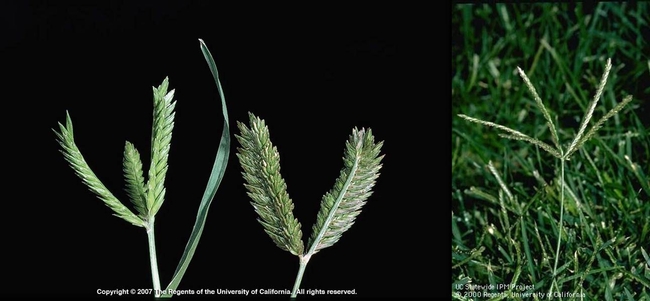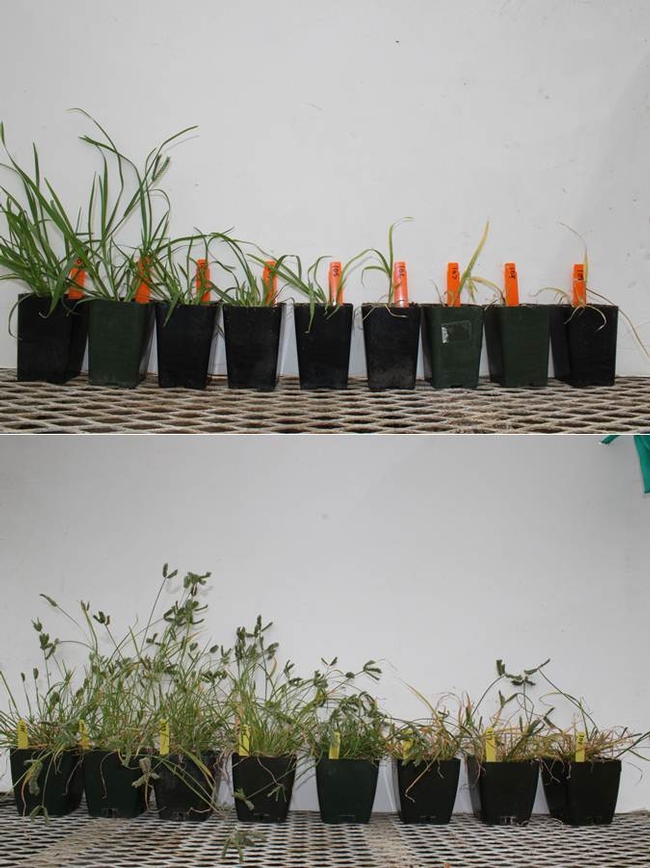In the past couple of years, I've gotten a lot of questions about goosegrass in orchard production systems, particularly about suspected glyphosate-resistant biotypes.
From a California orchard standpoint, we have two main goosegrasses (Eleusine spp) to deal with; these are goosegrass (Eleusine indica) and threespike goosegrass (Eleusine tristachya). These species are fairly similar but have quite different flowers (see the photo below).
According to the Weeds of California and Other Western States, goosegrass is a summer annual (or occassionally a short-lived perennial) while threespike goosegrass is a perennial (or sometimes annual) species. These grass weeds are spreading, tufted/bunched, low-growing species. So far, these weeds seem to be most problematic in Northern San Joaquin Valley counties but could be adapted to other similar cropping system as well.
Goosegrass (E. indica) is a worldwide problem and various populations have evolved resistance to a number of herbicide modes of action including glyphosate, ALS inhibitors, dinitroanalines, and ACCase inhibitors among others. Although we have not confirmed glyphosate-resistant goosegrass in CA, there is no reason to think that it can't (or hasn't) occured. No reports of herbicide-resistant threespike goosegrass (E. tristachya) are available at the International Survey of Herbicide Resistant Weeds, but given the amount of resistance in the genus, would not be unexpected either.
Following up on the threespike goosegrass research that Doug blogged about a few months ago and questions from The Almond Doctor, we looked at the susceptibility of threespike goosegrass to glyphosate in a small greenhouse study this summer. In this study, we collected threespike goosegrass from a field in Merced County in late 2012 and grew the plants to maturity and collected seed, then we planted seeds and sprayed them with a range of glyphosate doses from 1/8x to 16x a "normal rate" of 1 lb ae/A. (Please note that several of these are "off-label rates for research purposes only). The herbicide treatments were applied to small plants (about 2-tiller stage) and established plants (about 15-20 tillers).
As you can see from the photo above, threespike goosegrass is pretty hard to kill with glyphosate. Plants treated at the 2-tiller stage survived up to a 2x rate and but when treated a few weeks later at the 15-tiller stage they survived up to 16x! The 8x rate, second from the right, even had a few tillers flowering and setting seed within 4 weeks of the treatment. Although techncially we cannot call this population "resistant" because we didn't have a susceptible popultion to compare to, clearly this species is quite tolerant (if not confirmed resistant) to glyphosate.
We're going to delve into this a bit more this year with more greenhouse and field trials will be conducted to develop information on alternative strategies for this weed. I'm not sure what the best control will be for this species (or both goosegrasses) but I'm pretty confident that growers should not expect particularly good control of established clumps of threespike goosegrass with a preharvest glyphosate application.

